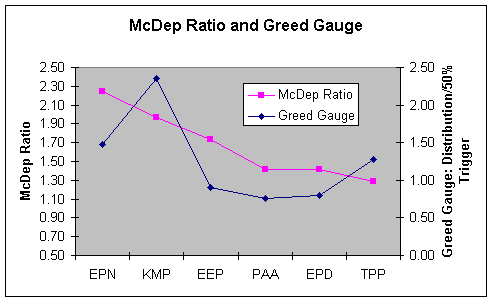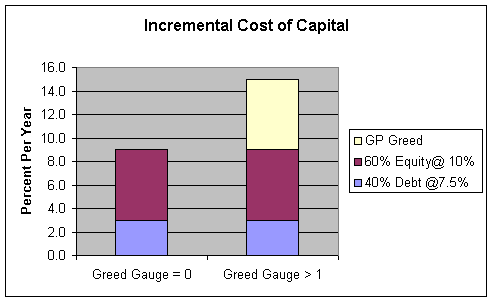Apparent
Vulnerability in High McDep Ratio, High Greed Gauge Stocks
For
the stocks with high McDep Ratio and high on the Greed Gauge, the risks seem
compounded (see Chart below). The
stocks are drawn from the Mid Cap and Small Cap Infrastructure Groups (see
Tables M-1, S-1).
When
the Greed Gauge exceeds 1.0 the general partner gets half of the incremental
cash distributed by the partnership. For
Kinder Morgan at a Greed Gauge reading above 2.3 the general partner's share of
all cash flow is about 40%.
A
high Greed Gauge reading indicates a heavy handicap in cost of capital.
New investments must exceed a high hurdle in order to earn the cost of
capital (see Chart). Considering
the high level of competition in the energy infrastructure industry and the
moderate historical returns, we are skeptical that there are few, if any, large
scale industry investments that will return enough to justify a high Greed Gauge
reading. Investors who buy high
greed gauge stocks are taking on an unnecessary handicap in giving the general
partner half of incremental cash distributed.
 |
 |
Our
suggestion that the cost of capital to a high greed gauge entity is high
contrasts to what a general partner might advertise. Low cost of capital is supposedly an advantage to investors
in limited partner units of KMP, for example. The common observation equates
cost of capital to the distribution yield, about 6.7% for the next twelve months
(see Table M-2).
It
seems obvious that investors are also looking for growth in the distribution.
Kinder Morgan feeds those expectations by projecting 12% growth in the
annualized rate at the end of 2002 compared to the end of 2001.
The dividend discount value model holds that rate of return equals
dividend yield plus growth. Thus we
suggest, at least for purposes of illustration, that limited partners are
expecting 10% per year return, not 6.7%. If
KM were to announce that there would be no further growth in the distribution,
stock price would probably decline and the current distribution yield would
rise.
One
might also consider that short-term interest rates are currently low thereby
promising lower debt costs than 7.5% that we use for illustration.
Perhaps, but we prefer to take a longer-term point of view.
Most
important, any cost of equity capital needs to be doubled to support the
incremental take of the general partner. Even
to meet the average current general partner take at Kinder Morgan, the combined
equity return would have to be 16.7%, if not 20%.
The
irony is that it is not too hard to meet a 15% return on investment on a
one-year basis. Apparently Kinder
Morgan buys assets for about 6 times Ebitda.
Turn that upside down and the asset returns 16.7% the first year if
projections are met. Allow a
generous 50-year life for the asset and deduct 2% of return for maintenance
capital. That leaves almost 15% to
cover interest and distributions.
The
problem is that something almost always happens that keeps companies from truly
earning the 15% returns managers think they see when they invest.
Moreover, sellers are not stupid. Few
would knowingly sell an asset that had a true 15% rate of return potential.
At the same time, there is competition to buy assets. Though no infrastructure partnership is as large yet as
Kinder Morgan, many are being formed. Those
with a low Greed Gauge reading have a competitive advantage over those with a
high Greed Gauge reading.
As
a result, the odds are stacked against new investors in high Greed Gauge stocks,
in our opinion. Compound that risk
with a high McDep Ratio and the odds of earning a substandard return rises even
further.